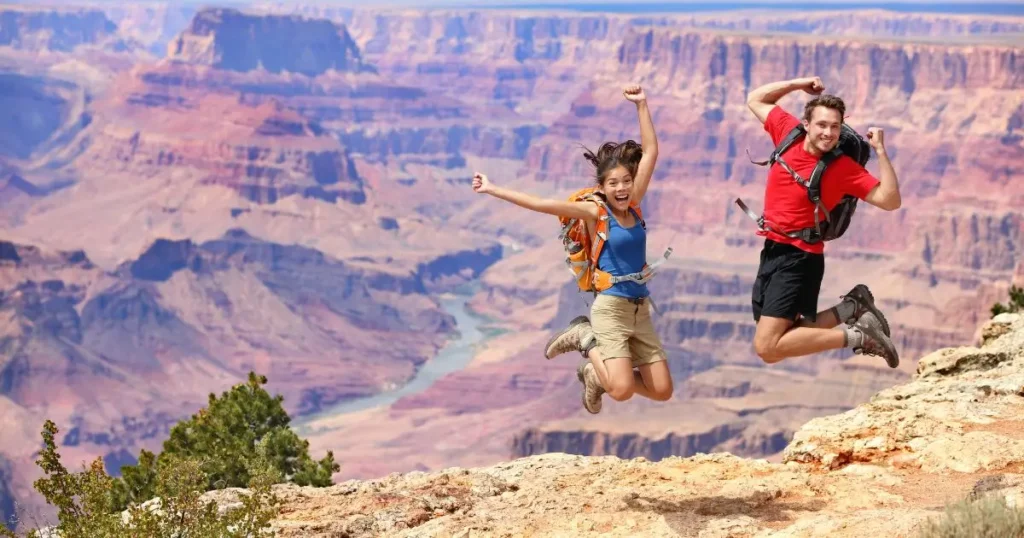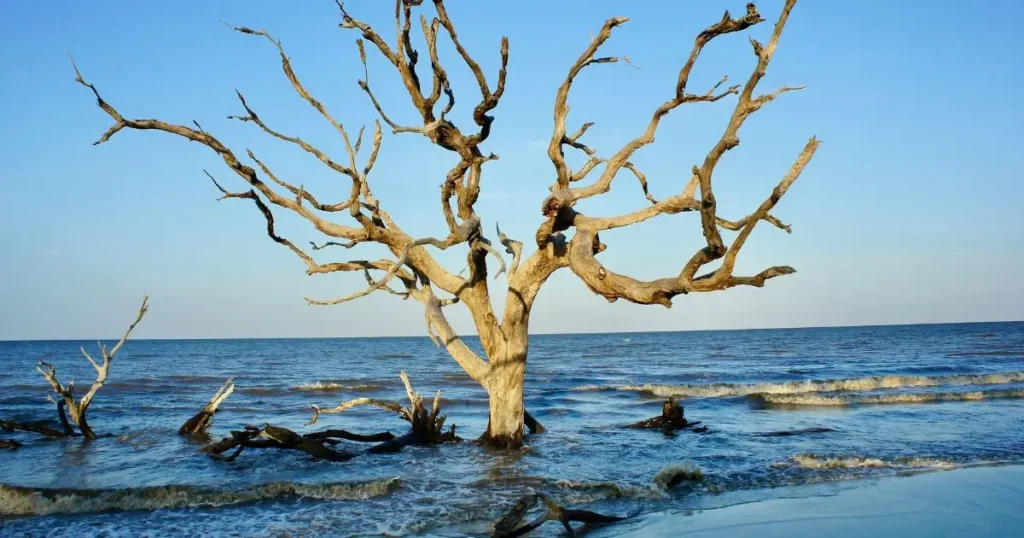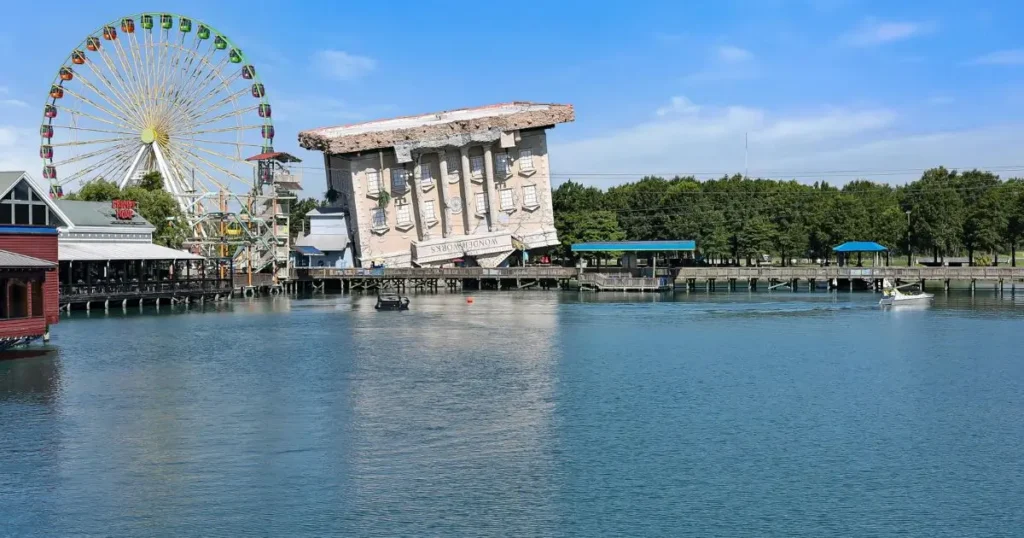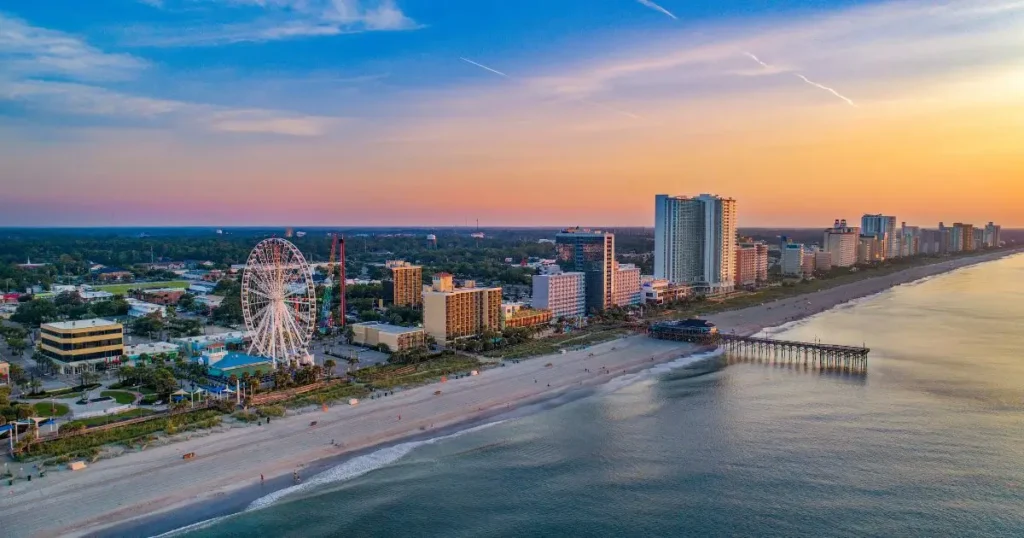Ever stood at the rim of the Grand Canyon and wondered if you picked the right time to visit? As the sun casts dramatic shadows across the vast expanse of colorful rock layers, you might find yourself questioning: would this view be even more magnificent in spring? Less crowded in fall? More dramatic with winter snow? The best time to visit Grand Canyon isn’t a one size fits all answer it depends entirely on what you’re seeking from this natural wonder.
Thinking about a trip to Arizona? You should definitely consider the Grand Canyon! I’ve seen it change through those super hot summers, calm winters, and the colorful changes of spring and fall. Honestly, each time of year makes the canyon look totally different, offers cool stuff to do, and has its good and not-so-good sides. When’s the best places to visit in Arizona, particularly the Grand Canyon, depends on what you’re looking for. Is it comfy weather? Smaller crowds? How easy it is to get around? Or maybe you’re all about snagging those amazing photos that you’ll remember forever? It’s all about what’s important to you!
Let’s explore when you should plan your visit to make the most of your Grand Canyon adventure.
Best Time to Visit Grand Canyon: Season by Season
One of the most remarkable aspects of the Grand Canyon is how dramatically it transforms throughout the year. Each season offers visitors a completely different experience, affecting everything from what you’ll see to how you’ll feel standing at its edge.
Spring in Grand Canyon (March-May)
Spring breathes new life into the canyon after the quiet winter months. As temperatures begin to rise, the park awakens with subtle but noticeable changes.
Weather Conditions
- Daytime temperatures typically range from 50-70°F, with cooler mornings and evenings
- Occasional rain showers occur, particularly in April, creating atmospheric conditions for photographers
- Snowmelt from higher elevations can affect trail conditions, particularly in early spring
Visitor Experience
- Crowds remain moderate until mid-May, offering a more peaceful experience than summer
- Wildflowers begin blooming along the rim in April and May, adding splashes of color to the landscape
- Wildlife becomes more active, increasing chances of spotting desert bighorn sheep, elk, and a variety of bird species
Advantages of Spring Visits
- Pleasant hiking temperatures make exploring rim trails and upper canyon routes comfortable
- Clear skies often provide exceptional visibility across the canyon’s vast expanse
- Shorter wait times for shuttle buses and popular lookout points
Challenges in Spring
- Weather can be unpredictable, with sudden temperature drops or unexpected storms
- Some North Rim facilities remain closed until mid-May
- Strong winds can sometimes make rim experiences less pleasant
Spring offers an excellent balance of good weather and manageable crowds, making it ideal for hikers and photographers who want to avoid summer heat and winter cold.

Summer at the Canyon (June-August)
Summer brings the Grand Canyon’s peak season, when the park buzzes with energy and activity from sunrise to sunset.
Weather Patterns
- Temperatures regularly climb between 75-105°F, with the inner canyon often exceeding 100°F
- July and August bring the monsoon season, with afternoon thunderstorms creating dramatic skies but potential safety hazards
- Heat becomes a serious consideration for any activity beyond rim viewing
Visitor Experience
- The park reaches its highest visitation, particularly around major holidays and weekends
- All services, ranger programs, and shuttle routes operate at full capacity
- Longer daylight hours allow for extended exploration and activities
Advantages of Summer Visits
- Access to all areas of the park, including the North Rim (open May 15-October 15)
- Extensive ranger led programs provide educational opportunities
- Evening programs and stargazing events take advantage of clear night skies
Challenges in Summer
- Extreme heat makes hiking below the rim dangerous without proper planning
- Popular viewpoints become crowded, especially during midday
- Accommodations within and near the park book months in advance at premium rates
Summer visits work best for families with school-age children, those interested in North Rim exploration, and visitors who prioritize full access to all park amenities despite higher crowds.
Fall Foliage Grand Canyon (September-November)
As summer heat fades, the Grand Canyon transitions into perhaps its most pleasant season, offering comfortable temperatures and dwindling crowds.
Weather Transitions
- Temperatures gradually cool to a comfortable 40-75°F range
- Precipitation remains minimal until late November, offering clear, stable weather
- First frosts typically arrive in late October or early November
Visitor Experience
- Crowds thin noticeably after Labor Day and continue decreasing through November
- Aspen groves on the North Rim transform with golden foliage in late September and early October
- Angled autumn sunlight creates dramatic shadows and enhances the canyon’s colors
Advantages of Fall Visits
- Nearly perfect hiking conditions with moderate temperatures
- Spectacular photography opportunities with clearer air and softer light
- More availability for lodging and dining reservations
Challenges in Fall
- Shorter daylight hours limit exploration time
- North Rim facilities begin closing in mid October
- Services gradually reduce as winter approaches
Fall represents perhaps the best overall season for most visitors, balancing good weather, reasonable crowd levels, and full access to most areas of the park.
Grand Canyon Winter Experience (December-February)
Winter transforms the Grand Canyon into a peaceful, snow dusted wonderland that few visitors get to experience.
Weather Conditions
- Temperatures typically range from 20-45°F with overnight lows sometimes dropping below freezing
- Snowfall occurs regularly at the South Rim, creating postcard-perfect views
- Ice can form on trails, particularly in shaded areas
Visitor Experience
- The canyon offers unparalleled solitude and quiet contemplation
- Snow covered rock formations create stunning contrast against the red canyon walls
- Clear winter air often provides the best visibility of the year across the canyon
Advantages of Winter Visits
- Nearly empty viewpoints allow for peaceful appreciation of the canyon
- Unique photographic opportunities when snow blankets the rim
- Significantly lower rates for accommodations within the park
Challenges in Winter
- North Rim closes entirely from mid October through mid-May
- Many services operate on reduced hours or close completely
- Road conditions can be challenging during and after snowstorms
Winter visits appeal to those seeking solitude, photographers chasing unique conditions, and budget conscious travelers willing to bundle up for the experience.
Grand Canyon Weather by Month: A Detailed Breakdown
Understanding the typical conditions each month helps pinpoint the perfect timing for your visit based on your weather preferences.
Early Year (January-April)
January Crisp winter conditions prevail with average highs of 40°F and lows around 18°F at the South Rim. Snow commonly dusts the rim, creating magical landscapes against the canyon’s warm colors. The North Rim remains closed, while the South Rim operates with reduced services but offers peaceful solitude for those who don’t mind bundling up.
February Similar to January, February maintains winter conditions with slightly warming trends toward month’s end. Snow remains possible, though storms typically drop less accumulation than earlier winter months. Visitor numbers remain at yearly lows, making this an excellent time for contemplative experiences without crowds.
March The transition to spring begins with temperatures ranging from 47-54°F during the day and dropping to the 20s at night. Weather becomes more unpredictable, with both snow and rain possible as winter releases its grip. Trail conditions improve gradually, though morning ice remains a consideration for hikers.
April Spring firmly takes hold with daytime temperatures reaching the 60s and nighttime lows in the 30s. Occasional rain showers bring desert wildflowers to life along the rims. Visitation increases during spring break periods but remains manageable compared to summer peaks.
Mid-Year (May-August)
May Pleasant temperatures in the 70s make May increasingly popular, especially later in the month. The North Rim typically opens on May 15, allowing access to this less-visited section of the park. Reservations become essential as summer approaches, particularly for lodging within the park.
June Summer arrives with consistent warmth, with South Rim temperatures reaching the 80s and inner canyon temperatures often exceeding 100°F. Crowd levels surge as schools release for summer break. Early morning and evening activities become preferable to midday exploration due to heat.
July The hottest month brings Grand Canyon temperatures year-round peak, with intense heat dominating the inner canyon. Afternoon monsoon storms create both spectacular cloud formations and dangerous conditions, particularly for hikers. Lightning safety becomes crucial during this period of unpredictable weather.
August Heat continues to dominate, though slight cooling begins toward month’s end. Monsoon patterns remain active, bringing afternoon thunderstorms that create dramatic photography opportunities but require weather awareness. Hydration and heat safety remain critical for all activities.
Later Year (September-December)
September A welcome cooling trend begins, with temperatures dropping into the 70s and low 80s. Labor Day marks the beginning of crowd reduction, though weekends remain relatively busy. Hiking conditions improve significantly as temperatures moderate in the inner canyon.
October Fall colors arrive on the North Rim, with aspen groves turning brilliant gold. Temperatures become nearly perfect for hiking, with daytime highs in the 60s and 70s. The North Rim closes for the season on October 15, concentrating all visitors at the South Rim for the remainder of the year.
November Temperatures cool noticeably, with highs in the 50s and overnight temperatures potentially dropping below freezing. The first winter storms may arrive, bringing snow possibilities later in the month. Crowd levels drop significantly after Thanksgiving, creating peaceful viewing experiences.
December Winter returns with temperatures ranging from 30-45°F and increasing chances of snow. Holiday periods bring brief visitation spikes, but the park remains relatively quiet. Winter solitude provides magical experiences for those prepared for cold conditions.
Best Season for Grand Canyon Trip: Comparing Options
Deciding when to visit often comes down to comparing seasons and understanding the tradeoffs between them.
Comparing Grand Canyon Summer vs Winter
Accessibility Differences Summer offers complete access to all park areas, including the North Rim and all trails. Winter significantly limits access, with North Rim closure and potential snow/ice impacts on South Rim trails. Summer provides more transportation options with all shuttle routes operating at full capacity.
Experience Contrasts Summer brings vibrant activity throughout the park but sacrifices solitude for crowds. Winter offers peaceful, contemplative experiences with viewpoints often completely empty. Photography differs dramatically, with summer providing longer daylight hours but winter offering unique snow conditions and clearer air quality.
Cost Variations Summer commands premium prices for all accommodations, with reservations required months in advance. Winter offers significant savings, with more availability and lower rates (holiday periods excepted). Restaurant and activity options reduce in winter but eliminate the need for reservations.
Comparing Spring and Fall
Weather Similarity Analysis Both seasons offer moderate temperatures ideal for hiking and outdoor activities. Spring tends toward more variable conditions with greater precipitation, while fall typically provides more stable, dry weather. Spring gradually warms while fall gradually cools, but both offer similar temperature ranges.
Visitation Differences Spring visitation builds gradually, with noticeable increases during spring break weeks and Memorial Day. Fall visitation decreases progressively after Labor Day, with weekdays becoming increasingly quiet. International visitors tend to favor spring slightly, while domestic travelers often prefer fall.
Natural Phenomenon Timing Spring brings desert wildflowers and increased water features from snowmelt. Fall offers aspen color changes on the North Rim and clearer air quality. Wildlife activity peaks during both seasons but with different species and behaviors visible during each.
Making Your Decision: Personalized Recommendations
Different visitor types have different priorities that might make certain seasons more appealing.
For Photographers
The best lighting conditions vary by season, with winter providing the clearest air quality and lowest sun angles for dramatic shadows. Spring and fall monsoon storms create dramatic cloud formations that transform standard canyon views. Early morning and late afternoon “golden hours” extend longer in summer but offer more comfortable shooting temperatures in spring and fall.
For Hikers
May and October typically provide optimal conditions for rim to rim attempts, offering moderate temperatures at all elevations. Day hikers find good conditions from March through May and September through November, avoiding summer heat that makes inner canyon trails potentially dangerous. Winter hikers should prepare for ice on upper portions of trails, bringing appropriate traction devices.
For Families with Children
Summer aligns with school breaks but brings challenging heat and crowds. Spring break weeks offer better weather but more concentrated visitation. Consider children’s heat tolerance when planning summer visits, particularly for hiking activities below the rim. Fall typically offers better overall experiences for families willing to take children out of school briefly.
For International Visitors
Combine Grand Canyon visits with other Southwestern destinations for efficient trip planning. International visitors typically find September-October and April-May ideal for experiencing multiple parks with good weather and manageable crowds. Allow extra time for potential weather delays during winter trips.
Planning Your Visit: Practical Considerations
Successful Grand Canyon visits require advance planning regardless of season.
Reservation Timelines by Season
Lodging within the park requires reservations up to 13 months in advance for summer dates. Spring and fall accommodations generally require 6-9 month advance bookings. Winter reservations (outside holiday periods) often remain available 2-3 months ahead. Backcountry permits for popular routes like Bright Angel and North Kaibab require application four months before intended hiking dates.
Transportation Considerations
Park shuttle schedules vary seasonally, with reduced service during winter months. Winter road conditions occasionally affect access, particularly during and immediately after snowstorms. Consider the Grand Canyon Railway as an alternative transportation option that operates year-round from Williams, Arizona.
Packing Recommendations by Season
Summer necessities: Wide-brimmed hat, high-SPF sunscreen, moisture-wicking clothing, multiple water containers, electrolyte supplements.
Winter essentials: Layered clothing, waterproof boots, traction devices for icy conditions, insulated jacket, gloves, warm hat.
Spring/Fall versatility: Layers for temperature fluctuations, rain gear, sun protection, light gloves and hat for cool mornings.
5 Things to Know Before You Go to Grand Canyon National Park
Explore more amazing Travel destinations for your next adventure!
FAQs: Your Grand Canyon Timing Questions Answered
What is the absolute best time of year to visit the Grand Canyon?
For most visitors, early Octob er offers the ideal combination of pleasant temperatures, reduced crowds, full services, and stable weather conditions. That said, the “best” time varies based on your priorities—photographers might prefer winter, while families often need to visit during summer break.
When is the Grand Canyon least crowded?
January and February typically see the lowest visitation, particularly on weekdays. Early December and late November (excluding Thanksgiving week) also offer relatively crowd-free experiences.
Is it worth visiting the Grand Canyon in winter?
Absolutely! Winter offers unique perspectives with potential snow contrasting against the canyon’s red rocks. You’ll encounter minimal crowds and experience a peaceful atmosphere impossible during busier seasons. Just prepare for cold conditions and reduced services.
Is it worth visiting the Grand Canyon in winter?
Absolutely! Winter offers unique perspectives with potential snow contrasting against the canyon’s red rocks. You’ll encounter minimal crowds and experience a peaceful atmosphere impossible during busier seasons. Just prepare for cold conditions and reduced services.
How hot does the Grand Canyon get in summer?
South Rim temperatures typically range from 75-85°F during summer days, while the inner canyon regularly exceeds 100°F, sometimes reaching 110-115°F at Phantom Ranch at the bottom. These extreme temperatures make summer hiking potentially dangerous without proper preparation.
When does the North Rim of the Grand Canyon open and close?
The North Rim officially opens May 15 and closes October 15 annually. These dates occasionally adjust slightly based on weather conditions, but services reliably operate during this five-month window.
What is the best month to avoid crowds but still have good weather at the Grand Canyon?
September offers an excellent balance of good weather and reduced crowds. The month starts busy around Labor Day but quickly becomes more manageable as children return to school, while temperatures remain pleasant for all activities.
Are Grand Canyon hotels cheaper during certain months?
January, February, and early December offer the lowest rates for in-park lodging, often 30-40% less than peak summer prices. November (after Thanksgiving) also provides good value. Book accommodations directly through the official park concessionaire for best rates.
When is the best time to hike to the bottom of the Grand Canyon?
May and October generally provide the most comfortable conditions for the strenuous rim-to-river-to-rim journey. Temperatures remain moderate at all elevations, and daylight hours provide adequate time for safe travel.
Can you see the Grand Canyon in one day, and when is best for a short visit?
Yes, you can experience the highlights in one full day, particularly during seasons with extended daylight hours. Spring and fall provide the best combination of comfortable temperatures and adequate daylight for short visits. Arrive early, utilize the shuttle system, and focus on the Scenic Hermit Road or Desert View Drive for efficient viewing.
How far in advance should I book Grand Canyon accommodations?
For summer stays, book 13 months in advance when reservations open. Spring and fall require 6-9 months advance planning. Winter visits (except holiday weeks) can often be arranged 2-3 months ahead. Always have backup lodging options in nearby towns like Tusayan or Williams.
Conclusion: Your Perfect Grand Canyon Moment Awaits
The Grand Canyon delivers awe-inspiring experiences year-round, but timing your visit to align with your priorities makes all the difference. Whether you seek perfect hiking temperatures in spring and fall, complete access during summer, or peaceful solitude in winter, each season offers something special for visitors.
Consider what matters most to you—weather comfort, crowd levels, specific activities, or photography conditions—then use this guide to select your ideal time frame. The canyon’s magnificent scale and beauty remain constant, but your experience will be shaped significantly by when you choose to stand at its edge.
Ready to plan your Grand Canyon adventure? Start researching accommodations for your target season now, as the perfect timing pairs best with the perfect place to stay. Your canyon moment is waiting—you just need to decide when to capture it.




